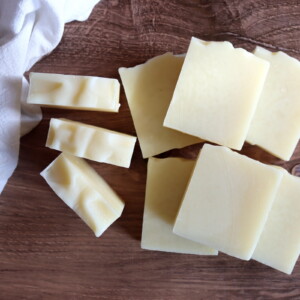
Homemade Tallow Soap
Tallow soap is deeply nourishing, whether made with pure tallow or with other oils added in.
Equipment
- Plastic (non reactive) measuring cups and containers
Ingredients
Balanced Cleansing Tallow Soap
- 12 ounces tallow 340 g
- 8 ounces coconut oil 227 g
- 8 ounces olive oil 227 g
- 8.83 ounces distilled water 250 g
- 3.95 ounces lye 112 g
Luxurious Tallow Soap with Milk and Honey
- 12 ounces tallow 340 g
- 8 ounces coconut oil 227 g
- 8 ounces olive oil 227 g
- 8.5 ounces frozen milk 241 g, cow, goat, or other
- 0.5 ounces distilled water 14 g
- 3.95 ounces lye 112 g
- 1 tsp honey 5 ml honey, mixed with 1 tsp (5 ml) water, total of 10ml honey/water solution
- 1 Tbsp powdered oats 7 g
Instructions
- The recipe above has ingredients for three variations on tallow soap. Choose one and follow the soapmaking instructions, do not use the ingredients for all three at once. All of the recipes for tallow soap listed above have the same basic instructions.
- Start by putting on protective clothing, and ensuring your work area is clean and well-ventilated.
- Stir the lye into the distilled water, carefully adding the lye a bit at a time.
- If making the milk soap recipe, you'll sprinkle the lye over the water and frozen milk cubes, adding a tiny bit at a time, and allowing the reaction to slowly melt the milk. The idea here is to keep the temperature low, so the milk sugars don't carmelize, so take your time.
- Once all the lye is stirred into the mix, set the lye water aside to cool to 100 to 110 degrees F (38 to 43 C). This will take 20 to 40 minutes, depending on the ambient temperature.
- Melt the tallow (and other oils, if using) and bring the mixture to roughly 100 to 110 F to roughly match the temperature of the cooled lye water.
- Gently pour the cooled lye solution into the oils, stirring by hand or using an immersion blender, until the mixture reaches trace.
- Finally, add in any mix-ins (if using), namely powdered oats, diluted honey or essential oils.
- Pour the mixture into soapmaking molds, either as individual molds or as a full loaf of soap for cutting later.
- Allow the soap to cure in the molds for about 24 to 48 hours, until it's firm enough to remove. Once the soap is firm, remove it from the mold. If you've made a loaf of soap instead of individual bars, cut the soap at this point. Be aware that tallow soap can be hard to cut if left as a loaf too long, so be sure to cut the bars as soon as the loaf sets.
- Place it in a well-ventilated space to cure for about 4 to 6 weeks, flipping the bars every week or so.
- At this point, the soap is ready to use or store.
Notes
If you've never made soap before, I strongly suggest reading my beginner's guide to soapmaking so you understand the equipment and terminology.
The recipe above has ingredients for three variations on tallow soap. Choose one and follow the soapmaking instructions, do not use the ingredients for all three at once.
The first recipe for old-fashioned 100% tallow soap is deeply nourishing for skin, but not nearly as "cleansing" or harsh as modern soaps. It has minimal lather, and forms a very hard bar. It won't dry out your skin, and it's a great facial cleanser.
For more cleansing power, you can add coconut oil which creates a bubbly lather and is an excellent cleanser. Tallow soap on it's own makes a very hard bar, where as olive oil creates a very soft bar. Adding olive oil will soften the bar and give it a nice creamy lather.
The final tallow soap recipe listed adds in milk, honey, and oat powder for a more luxurious spa-type soap. Milk soaps are deeply conditioning for skin, and honey helps the skin retain moisture. Oats soothe dry chapped skin. These add ins can also be added to the 100% tallow bar if you choose.
If you want to add fragrance, you can add essential oils of your choice to any of these recipes at trace. The general guideline is about 30 to 35 grams, depending on the fragrance.
Tried this recipe?Let us know how it was!